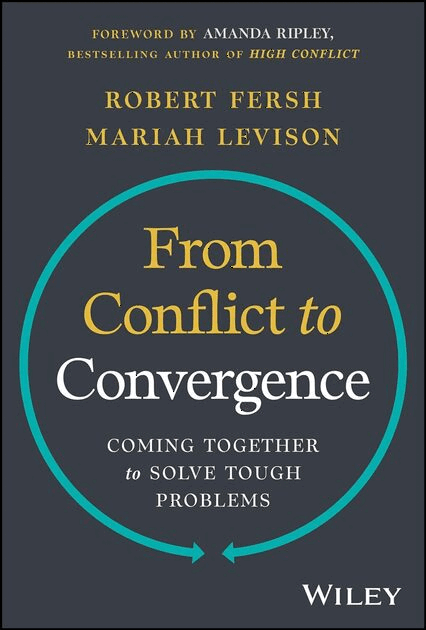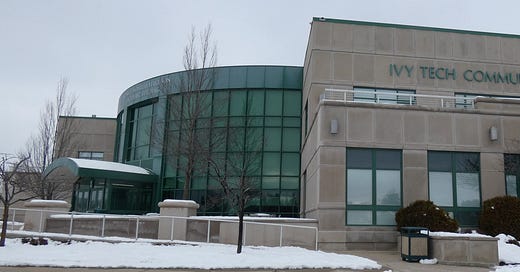How one community college course is teaching students to collaborate across political divides
An unlikely partnership between an Indiana community college and a national nonprofit is helping students learn how to solve problems and have productive dialogue alongside people they disagree with.
In recent years the United States’ growing political polarization has begun to evolve into something more corrosive: Affective polarization, defined as a phenomenon in which individuals' feelings and emotions towards members of their own political party or group become more positive, while their feelings towards members of the opposing party or group become more negative.
In other words, Americans of different political orientations no longer merely disagree on policy. Increasingly, we dislike and distrust people who identify with different political parties or movements.
On college campuses, this phenomenon can have a significant impact on students, who are often passionate about issues but lack meaningful experience or instruction on how to have productive interactions with people who don’t agree with them. Its corrosive impact is felt in the classroom and throughout campus life.
Taking on polarization, one classroom at a time
We are colleagues at Ivy Tech Community College in Bloomington, Indiana. In a college town in the heart of a conservative state, students’ political views range from intensely conservative to intensely liberal. There is one thing, however, that nearly all of them agree on: They want to stop being angry and fighting about everything having to do with politics. For most students, the solution has been silence. They avoid reading, seeing, or talking about political issues. That solution is not helpful - especially in co-author Lynn Schoch’s composition class, which teaches students how to construct an argument.
For years, Lynn’s composition class course work consisted primarily of four formal papers each student had to complete individually, in which they were asked to make the strongest possible case for or against an assigned topic based on their own research. The traditional approach was useful in teaching students to construct strong arguments, but Lynn found that in subsequent class discussions, the students’ arguments - especially those that touched on controversial topics - garnered little to no productive engagement across different opinions.
Students who agreed, said so. Students who disagreed either dismissed all arguments that contradicted their world view, or disengaged entirely.
A new methodology

In 2021, Lynn changed his composition class curriculum in an attempt to help students more productively engage with one another across significant differences of opinion and belief. He now bases the course’s core project on a collaborative dialogue methodology developed by Convergence, a national nonprofit dedicated to building trust and bridging divides “to solve critical challenges and strengthen our democracy and society.”
Convergence’s methodology, which the Washington, DC-based group typically applies to significant national policy issues such as reimagining public education, re-entry to society for the formerly incarcerated, and supports for working families, can be summarized in five steps, according to the organization:
Identify and select “ripe and amenable” issues that “stakeholder-participants can collaboratively ‘unstick’” if framed in a way that’s inviting to multiple viewpoints. Typically, these are issues for which deep ideological or political divides have prevented important progress (such as improving the state of public education in the U.S.), but for which opposing stakeholders may share at least one overarching shared goal (such as ensuring every child has access to quality education).
Convene “diverse tables of participant leaders and doers.” Ideally, these tables would include people with a wide range of knowledge, experience, perspectives, and influence on a given issue, which would in turn facilitate the implementation of their solutions should they reach a consensus.
Help participants “build trust, find common ground” by discovering shared values and interests. This is assisted by a set of ground rules that requires participants to honor “all points of view,” respect “the confidentiality of the conversation,” and “listen carefully when others speak,” in order to create a safe space for all participants to express their opinions openly.
Generate consensus solutions through collaborative dialogue guided by Convergence team members. These facilitated discussions often begin with “establishing guiding principles that create a framework for the policy discussions to come” and then progress toward substantive ideas and solutions that fit the stakeholders’ shared vision.
Stakeholders then work together to implement the proposed solutions, often with support from Convergence.
After looking into Convergence, Lynn realized that the group’s methodology might offer a way to teach students to craft arguments that foster productive, ongoing dialogue that engages other perspectives, as opposed to the status quo that rarely fostered substantive back-and-forth. He revised his course by reducing the number of formal papers by two and replacing them with informal weekly responses to readings on Convergence’s method, as well as group activities that mirror some of the trust-building exercises Convergence uses to build relationships between stakeholders on a given issue. Lynn also brings Convergence’s founder, Rob Fersh, into his classroom each semester via zoom to speak to classes about the practical applications of Convergence’s methodology, the real-world impact it has made, and the everyday situations it can be applied to. (Editor’s note: Rob Fersh’s son, Danny, is one of the editors of the State of the Student Vote substack. To account for potential bias, Danny ceded final editorial decisions to other members of the Substack’s editorial team with regards to this article).
With Rob’s help, Lynn’s classes have field-tested many of the ideas and exercises that Convergence practices in their work and that are explained in the 2024 book, “From Conflict to Convergence: Coming Together to Solve Tough Problems,” which Rob co-authored along with current Convergence CEO and President Mariah Levison.
Annie Gray, this article’s other co-author, discovered the Convergence method after sitting in on one of Rob’s Zoom visits to Lynn’s class. Impressed by the positive response from Lynn’s students, Annie has sought ways to use the Convergence method in her role as Dean, where challenges and conflicts among faculty and staff are commonplace. She believes doing so can provide significant value to her and her team, with the potential to create a foundation of collaboration and trust that, over time, could empower her Ivy Tech colleagues to share their perspectives with less trepidation, in a way that helps generate more creative solutions to shared problems.
With Annie’s support, Lynn now incorporates Convergence’s methods into a project on critical thinking and writing that his students complete each semester.
How to teach Convergence
At the beginning of each term, Lynn has to establish credibility with a new set of students who often begin his class suspicious that their professors may attempt to brainwash them, or will find them lacking in skill or intelligence. He addresses these suspicions head-on with strong reassurances that the Convergence method does not seek to change any opinions. Rather, it aims to change the way people think about their own opinions and those of people they disagree with by emphasizing three lessons:
Your opponent is not your enemy.
Your opponent is not dumb.
Write or speak in a way that your opponent will want to listen.
To achieve student buy-in and establish real-world applications for the project, Lynn assigns several readings to help students familiarize themselves with Convergence’s methodology, including an Atlantic article from 2009 about how people process evidence that contradicts their pre-existing opinions, articles from The New York Times and Philanthropy for Active Civic Engagement about Convergence’s work and methodology, a guest essay Rob authored for the American Bar Association’s Just Resolutions Newsletter, and an op-ed Rob co-authored for The Hill titled “We agree on almost nothing except how to solve problems across the political divide.” These readings are key because they demonstrate that the project will focus on practical uses and experience rather than theory. Future classes will be assigned portions of the book about Convergence’s methodology that Rob co-authored with Mariah Levison.
One core tenet of Convergence’s methodology is building trust between people from differing sides of a given issue. While Convergence often hosts dinners or mixers for the stakeholders it brings together for its projects, community college students often are working or raising a family; their busy schedules make it impossible to to bring students together for a mandatory social event. Instead, during three-hour class sessions, Lynn incorporates interactive discussion prompts that encourage students to share their perspectives in randomly assigned small groups using the Convergence method. Issues for discussion avoid the most polarizing political issues in favor of less threatening but still controversial subjects, including “canceling” historical figures, social media shaming, crime and punishment, conspiracy theories, and socioeconomic divides. These sessions help students build relationships with each other while also versing them in the methodology they’re preparing to use.
Following the group activities, take-home assignments ask students to explore specifically selected issues and game out how they would use the Convergence method to identify the correct stakeholders and then bring them toward consensus on the issue. Additional prompts ask students to consider hypothetical interactions with people in their lives who have rigid political views, as well as with family members. Students then apply insights from their readings and class discussions to see how the Convergence method could yield a more positive outcome.
The upshot
As writing instructors, one of the biggest challenges we’ve faced with students is in helping them escape the trap of confirmation bias. They seek out the evidence that confirms what they already believe, and they ignore what might challenge their ideas. If taught to students, we believe the Convergence method has the potential to counter this tendency; it shows students the value of putting their preferred evidence aside temporarily and listening to others in order to unpack the underlying reasons for their perspectives. Very often, students then discover a commonality or shared ground that transfers to their academic work in the form of more nuanced understanding of a topic, fairer representations of opposing viewpoints, and better ability to appeal to diverse audiences.
At the end of each term, Lynn asks students to identify one thing they will remember most from his class. The most common response is “Convergence.”
I … think the Convergence section of this class helped me to evaluate two different viewpoints and showed me how to bring two opposing sides together in a way that promoted discussion and resolution. I feel that after taking this class and doing these exercises in order to understand opposing viewpoints more, I will truly listen more, and not judge others based on their personal beliefs without knowing their side of the story.
-Student response to Lynn Schoch’s end-of-term survey
The one thing that I will remember the most from this class is the lessons we learned from convergence. Before this class, I never thought to see the reasoning behind someone's viewpoint, I just immediately dismissed them and didn’t think to hear them out. I feel like I’ve learned a lot about how it can be useful to understand someone, rather than to think they’re wrong.
-Student response to Lynn Schoch’s end-of-term survey
Students also frequently say they feel more able to express their true opinions during group activities, secure in a more intimate setting and with the knowledge that they won’t be attacked for expressing themselves. Some students have even reported trying the Convergence method with friends and family, successfully improving relationships with “grumpy uncles and grandfathers.”
At the beginning of each term’s Convergence project, Lynn poses a multiple choice question to his students: “Which of the following is the best outcome of an argument?” The possible answers are then revealed to the class one at a time, in the following order:
You’re full of $#*!
Let’s not talk about this anymore.
Sure. You win.
You have convinced me that I am wrong, and I will change my opinion.
I understand where you are coming from. You haven’t convinced me, but you made me reconsider my opinion.
The obvious answer, made especially so by what students learn during the Convergence project, is number five. Political discourse on college campuses rarely leads to such conclusions. And the seeming inevitability of more negative endings have made political discourse fraught, difficult, and undesirable in many settings where a productive exchange of ideas could do enormous good.
By equipping students with the tools to disagree productively, and bond across differences, we can encourage civic engagement by removing some of its most taxing elements.







Lauren—Thank you for the positive comment and mention of my course at Ivy Tech. It is good to see, as you describe, the variety of ways to approach the problem of polarity. I was particularly struck by your comments about Storycorps. For a long time, one of my duties was to oversee the university's international center—a recreational and gathering place for international students. Multicultural education was a hot top for my colleagues, and they often disagreed with my take on the matter. The coach of the center's intramural soccer team complained to me one day that he couldn't coach because most of the students were just learning English. I told him to teach them what "Man on" means and then let them do the rest. The team worked great together. We had a string quartet made up of students with four different languages and homes on four different continents. They played beautifully together. I have always felt strongly that the best way to address multicultural issues was to put mixed groups together to complete a task—as long as that task did not include discussing multicultural issues. That may apply to polarizing issues as well.
Loved the ideas here. Wrote about it and linked to it on my substack: https://laurenbrownoned.substack.com/p/across-the-big-divide-thoughts-on